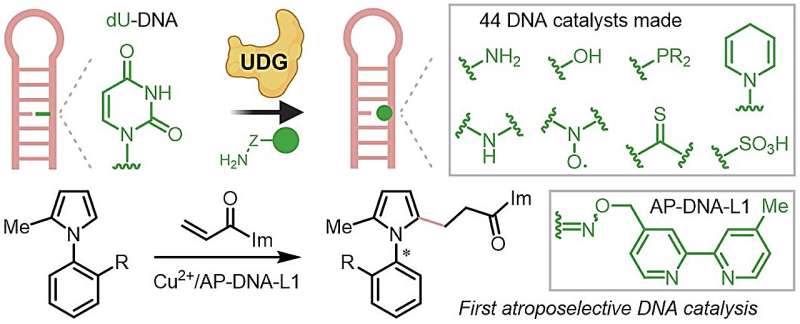Researchers from the National University of Singapore have developed a novel method to create diverse chiral DNA catalysts, paving the way for more efficient and versatile approaches to asymmetric catalysis. This breakthrough simplifies the production of DNA catalysts, making it accessible to non-specialists and opening up new possibilities in sustainable chemical synthesis.

Harnessing DNA’s Potential for Asymmetric Catalysis
Enzyme catalysis, which uses biological proteins to accelerate chemical reactions, has emerged as a sustainable approach to producing chiral molecules. However, the use of proteins as catalysts poses challenges, as they are often unstable and require complex DNA manipulation for their design.
To address these issues, scientists have turned to DNA as a more stable and cost-effective chiral scaffold for sustainable asymmetric catalysis. DNA’s unique base-pairing mechanism also makes it highly programmable, offering precise control over its structure and function. The research team from the National University of Singapore has developed a method that takes advantage of an enzymatic process called DNA repair and combines it with biorthogonal chemistry to create chiral DNA catalysts.
This innovative approach simplifies the production of DNA catalysts, allowing even non-specialists to perform DNA catalysis without the need for advanced instruments or expertise. Moreover, the bioorthogonal chemistry reactions used in this method proceed without interfering with any functionality, making it highly compatible with diverse functional groups.
Expanding the Capabilities of DNA-Based Catalysis
The researchers have built a library of 44 DNA catalysts using this new approach, which combines chemical reactions with enzymatic processes. These newly developed DNA catalysts have demonstrated superior performance in terms of enantioselectivity, substrate scope, and overall reaction efficiency compared to previous versions.
Moreover, the team has achieved a significant milestone by demonstrating the first example of atroposelective DNA catalysis, successfully generating axial chiral compounds that are typically challenging to synthesize using bio-catalysis methods. This breakthrough showcases the versatility and potential of DNA-based catalysis.
The robustness of this method is further highlighted by its ability to assemble a wide variety of structurally distinct DNA catalysts with unprotected functional groups. This is a significant advancement, as it eliminates the need for complex and expensive solid-phase synthesis techniques that were previously required for DNA catalysis.
As Professor Zhu Ru-Yi, the leader of the research team, explains, “Our method lowers the barrier significantly for conducting DNA catalysis, which previously required highly specialized, expensive and challenging solid phase synthesis.” This development is expected to attract more researchers to explore the great potential of DNA catalysis and contribute to the advancement of this exciting field of study.
Unlocking the Potential of Sustainable Chemical Synthesis
Looking ahead, the research team is actively designing new strategies to develop selective and sustainable chemical reactions via DNA catalysis. This approach holds promise for a wide range of applications, from the production of pharmaceuticals and agrochemicals to the development of sustainable materials.
By harnessing the unique properties of DNA, such as its programmability and stability, the researchers are paving the way for more efficient and environmentally-friendly chemical synthesis. The implications of this breakthrough extend beyond the laboratory, as it could contribute to the development of greener and more cost-effective approaches to the production of essential chemicals and materials.
As the field of DNA catalysis continues to evolve, we can expect to see further advancements in the coming years. This research from the National University of Singapore is a significant step forward, demonstrating the immense potential of DNA-based catalysts to revolutionize the way we approach sustainable chemical synthesis.
